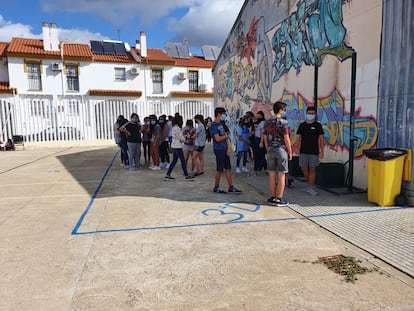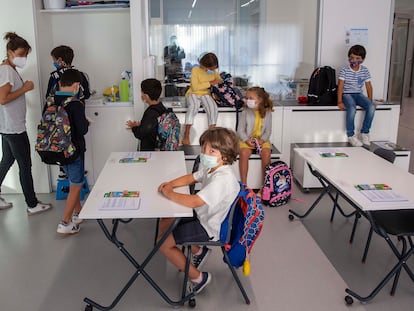As cold sets in, Spanish schools face dilemma: leave windows open or risk coronavirus contagion?
The safety protocols negotiated between central and regional education authorities make no provisions for the drop in temperature, and some students are forced to sit near wet, drafty spots


It was raining last Friday in Puerto de Santa María, in Spain’s southern Cádiz province. Pablo del Pozo, a music teacher at a local secondary school, was asked by a student if they could close the window. He answered no, due to coronavirus protocols. Del Pozo shared this episode on social media, along with a photograph showing the wet window sill and a student desk placed just centimeters away. The post triggered a deluge of reaction.
Following coronavirus safety protocols, there are 23 students per classroom at this particular school, and a distance of 1.5 meters between each desk. This means that some students are forced to sit very close to the windows. “It’s already cold, but we are forced to keep all windows and doors open to prevent contagion. We are being told that it’s better for a child to catch pneumonia than Covid-19,” says Del Pozo, who criticizes the fact that the government has not come up with a protocol for class ventilation specifically adapted to the fall and winter months.
The same concern has been spreading across schools in all parts of Spain after the scientific community last Monday warned that the risk of coronavirus contagion in indoor settings could be nearly 20 times higher than outdoors. Educators and parents are now wondering how to manage proper ventilation while preventing students from feeling cold inside classrooms where they are forced to sit for prolonged periods of time.

The coronavirus protocol negotiated between central and regional health authorities does not contemplate a different scenario for the winter. The recommendations are for at least 10 to 15 minutes of ventilation at the beginning and end of each school day, and also during recess and between classes. In general, windows should remain open “as long as possible.” The regional governments of Extremadura, Murcia, Andalusia and the Canary Islands have recommended keeping doors and windows open during class as well.
“Ventilating only during recess and in between classes is clearly insufficient,” explains María Cruz Minguillón, a researcher at the Spanish National Research Council (CSIC)'s Institute of Environmental Assessment and Water Research. “The windows must stay open and the children must wear a coat and scarf if necessary,” adds this expert in airborne aerosols.
Ever since schools reopened in September, most of them have been keeping doors and windows open to achieve cross ventilation and reduce the risk of coronavirus transmission. So far, only 0.73% of classrooms across the country (around 2,300) have had to shut down due to positive cases among students or teachers, according to the Education Ministry.
But temperatures are starting to drop in some Spanish regions, particularly in the north, and keeping windows open all day is becoming a problem. Bárbara Menéndez, a deputy principal in charge of coronavirus management at a public school in Asturias, reports that some “children’s heads” are situated right next to the windows, and that due to safety protocols, it is always the same children because they cannot change desks. Last week, a storm forced the school to roll the window blinds halfway down so that the rain would not “come pouring in.” Menéndez notes that “in Asturias, we have cold and rainy weather eight months out of the year.”

Researchers are now insisting on the need to review school ventilation protocols, and to consider purchasing mechanical ventilation systems in areas with less benign weather conditions. “If a school is thinking about closing windows, it will have to use tools such as CO2 sensors and air purifiers with HEPA filters,” warns Minguillón.
CO2 sensors, which are priced at around €35, detect the concentration of carbon dioxide in the air and determine the need for fresh air to reduce the risk of contagion. Air purifiers with HEPA filters, which can cost around €600 for a 40-square-meter room, clean the air by removing contaminants.
Minguillón has translated into Spanish the “Five-Step Guide to Checking Ventilation Rates in Classrooms,” published by the Harvard School of Public Health. This expert warns that buying a CO2 sensor is not enough. “After that, you have to make a series of calculations considering variables such as the number of students per classroom, their age, and the volume in cubic meters in each classroom, among others,” she notes.
But to many educators, terms such as CO2 sensors and HEPA filters sound unfamiliar. Neither the Health nor the Education ministries mention them in their protocols. Nor do the regional governments, although some are considering adopting new ventilation methods when the weather turns cold.
Jordi Sunyer, head of the Childhood and Environment Program at the Barcelona-based Institute for Global Health and one of Spain’s top experts on Covid-19 and schools, believes that the country still lacks protocols establishing how to ventilate classrooms that have no windows or just one. Sunyer believes that in these cases, authorities should consider options such as air purifiers with HEPA filters. “They filter all the ultrafine particles, they capture all the viruses,” he says. “They are portable, they can be used in more than one classroom, and they would only be necessary for rooms without good natural ventilation.”
An unwanted choice
Faced with a shortage of tools and information, many teachers feel all alone to deal with a dilemma that they say should not be in their hands. Should students be cold in class and receive their education in subpar conditions, or should windows be closed despite the increased risk of coronavirus contagion?
Some educators have taken the initiative. Francisco Espada, a teacher at the Cádiz public secondary school Antonio de la Torre, first heard about CO2 sensors and air filters two weeks ago on a television program. He has since been doing extensive online research and advising his school. “We are going to buy several CO2 sensors to check that our classrooms are safe. The principal thought it was a good idea,” he says.
But the CSIC expert Minguillón insists that just taking a reading from a sensor is not enough: other factors have to be taken into account, such as the classroom volume or the number of students in it.
Esteban Álvarez, the principal of a public secondary school in the Guadarrama mountains, in the Madrid region, has already figured out how much it will cost to keep the windows open in the winter. In a normal season, the school turns on the heating at 7am and turns it off at 11.30am. This comes out to around €20,000 to fill the diesel tank. This year, the heating will remain on until 2pm, bumping up the bill to €40,000.
“We can already feel the cold, and we are starting to open up half the windows. Nobody has told us whether it is a good idea to buy air purifiers; this subject has not been addressed by the administration, which will improvise as usual,” he notes.
The school does not have a lot of money anyway, he explains: they have received an additional check for around €50,000 from the government of Madrid to cover the costs of dealing with the pandemic, such as buying face masks, hand sanitizer, digital devices and improving the Wi-Fi connection.
Other countries
In the United States, the protocol from the Centers for Disease Control considers the use of air purifiers with HEPA filters. Germany’s Länder recently decided in favor of natural ventilation, establishing five minutes of open windows every 20 minutes. In the southern region of Bavaria, air purifiers and CO2 sensors will be used in rooms that cannot be properly ventilated with natural methods. In the United Kingdom, the government has not changed its ventilation guidelines despite the drop in temperatures.
Tu suscripción se está usando en otro dispositivo
¿Quieres añadir otro usuario a tu suscripción?
Si continúas leyendo en este dispositivo, no se podrá leer en el otro.
FlechaTu suscripción se está usando en otro dispositivo y solo puedes acceder a EL PAÍS desde un dispositivo a la vez.
Si quieres compartir tu cuenta, cambia tu suscripción a la modalidad Premium, así podrás añadir otro usuario. Cada uno accederá con su propia cuenta de email, lo que os permitirá personalizar vuestra experiencia en EL PAÍS.
¿Tienes una suscripción de empresa? Accede aquí para contratar más cuentas.
En el caso de no saber quién está usando tu cuenta, te recomendamos cambiar tu contraseña aquí.
Si decides continuar compartiendo tu cuenta, este mensaje se mostrará en tu dispositivo y en el de la otra persona que está usando tu cuenta de forma indefinida, afectando a tu experiencia de lectura. Puedes consultar aquí los términos y condiciones de la suscripción digital.
More information
Últimas noticias
Most viewed
- Sinaloa Cartel war is taking its toll on Los Chapitos
- Oona Chaplin: ‘I told James Cameron that I was living in a treehouse and starting a permaculture project with a friend’
- Reinhard Genzel, Nobel laureate in physics: ‘One-minute videos will never give you the truth’
- Why the price of coffee has skyrocketed: from Brazilian plantations to specialty coffee houses
- Silver prices are going crazy: This is what’s fueling the rally










































